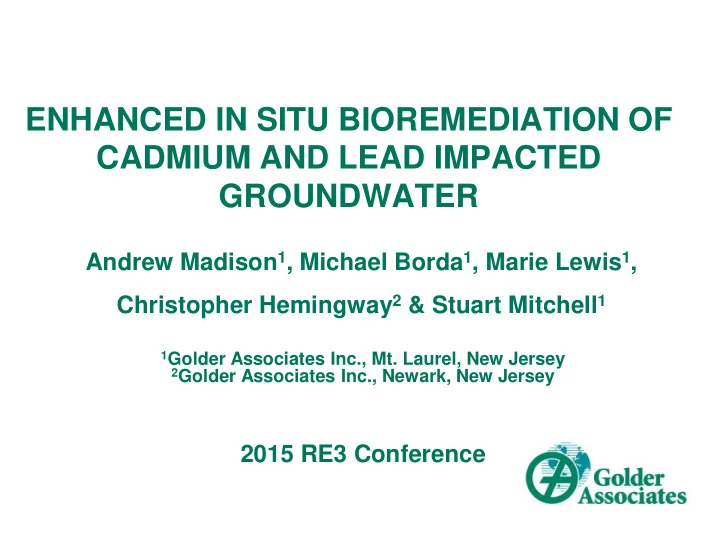

ENHANCED IN SITU BIOREMEDIATION OF CADMIUM AND LEAD IMPACTED GROUNDWATER Andrew Madison 1 , Michael Borda 1 , Marie Lewis 1 , Christopher Hemingway 2 & Stuart Mitchell 1 1 Golder Associates Inc., Mt. Laurel, New Jersey 2 Golder Associates Inc., Newark, New Jersey 2015 RE3 Conference
Objective Develop and implement an efficient and cost-effective treatment strategy to reduce concentrations of cadmium and lead in groundwater prior to discharge to a local creek. September 25, 2015 2
Site Background Former lead-acid battery Creek manufacturing facility (local discharge) Septic system of the Former Sales Office (FSO) introduced cadmium (Cd), lead (Pb) and increased acidity to Septic groundwater System Septic system and piping was removed in 1991 Former Cd impacts have been Sales observed in a local creek that Office borders the Site and is (FSO) downgradient of the FSO 3
Site Background – Cd Impacts Cd Isoconcentration Contours ( μ g/L) September 25, 2015 4
Site Background – Pb and pH Pb Isoconcentration pH Contour ( μ g/L) September 25, 2015 5
Site Background – Creek Impacts Cd & Pb Impacted Groundwater Seeps September 25, 2015 6
Pilot Study - Geochemical Setting Mobility of Cd is controlled by chemical speciation which is dependent on pH and redox state (measured by oxidation reduction potential [ORP]) Geochemical modeling of current Site conditions indicated that Cd was highly soluble: 80% of total Cd was present as Cd 2+ 20% of total Cd was present as CdSO 4 (original form) Indigenous microorganisms were limited by the lack of available organic carbon System was anaerobic and electron acceptors (oxygen, iron-oxides, manganese-oxides) were limited; however groundwater had elevated levels of sulfate September 25, 2015 7
Pilot Study Design Goal: Stimulate indigenous sulfate reducing microorganisms to generate sulfide to precipitate Cd and Pb as insoluble metal sulfide species (CdS, PbS and mixed Cd- and Pb-iron sulfides) Process: Intrinsic microbes obtain energy from the oxidation of the injected organic carbon substrate (i.e., lactate) By providing organic carbon, microbial reduction of sulfate to sulfide will be enhanced 2- S 2- + CO 2 + H 2 O (CH 2 O) n + SO 4 Cd 2+ CdS (s) September 25, 2015 8
Pilot Study Implementation Installed one injection well (IW-1) Installed several monitoring points along primary groundwater flowpaths September 25, 2015 9
Pilot Study Implementation – Bromide Tracer Prior to initiation of bioremediation approach, a tracer test was conducted A known concentration of bromide was injected into IW-1 and monitored for 1-month using ion-specific electrodes Confirm primary groundwater flow paths within the Pilot Study Area Evaluate effects of dilution and dispersion of the amendment solution September 25, 2015 10
Pilot Study Implementation – Lactate Injection 4 Quarterly Lactate (NaC 3 H 5 O 3 ) Injections in IW-1: June 2012 – 25 kg of lactate in 1,000 gallons of water Mass of lactate was designed based on a stoichiometric electron donor demand calculation (i.e., enough lactate to exhaust electron donors [oxygen, nitrate and iron-oxides] and drive sulfate reduction) and expected dilution across Pilot Study Area September 2012 – 75 kg of lactate in 1,000 gallons of water December 2012 – 75 kg of lactate in 1,000 gallons of water March 2013 – 75 kg of lactate in 1,000 gallons of water September 25, 2015 11
IW-1 Results - TOC September 25, 2015 12
IW-1 Results – Geochemical Conditions Shift to Iron Shift to Sulfate Reducing Reducing Conditions Conditions and Formation of FeS x September 25, 2015 13
IW-1 Results – Cd and Pb Cd and Pb below groundwater MCLs since November 2012 September 25, 2015 14
MW-29 Results – TOC September 25, 2015 15
MW-29 Results – Geochemical Conditions Shift to Sulfate Reducing Conditions and Formation of FeS x Shift to Iron Reducing Conditions September 25, 2015 16
MW-29 Results – Cd and Pb Cd and Pb below groundwater MCLs downgradient of IW-1 since February 2012 September 25, 2015 17
MW-26 Results – TOC 400 ft Downgradient of IW-1 September 25, 2015 18
MW-26 Results – Geochemical Conditions Shift to Sulfate Reducing Conditions Shift to Iron and Formation of Reducing FeS x Conditions September 25, 2015 19
MW-26 Results – Cd and Pb Geochemical changes 400 feet downgradient of IW-1 were observed in MW-26 September 25, 2015 20
Pilot Study Conclusions Natural geochemical conditions can be favorably modified by addition of organic carbon (i.e., lactate) Addition of lactate promoted microbially-mediated sulfate reduction sufficient to sequester Cd and Pb in the immediate area of injection Geochemical changes were stable for greater than an 18-month period and were observed approximately 400 feet downgradient of IW-1 Concentrations of Cd and Pb remained below groundwater MCLs for greater than an 18-month period following cessation of pilot injections September 25, 2015 21
Full-Scale Implementation Full-scale implementation is currently ongoing September 25, 2015 22
Recommend
More recommend